What is tax-loss selling in penny stocks? I answered a question about tax-loss selling in the latest edition of the Millionaire Mentor Update. In this post I’ll go into more detail and share more examples.
We’re coming up on the end of the year, both calendar and fiscal. That means tax cutoffs. It can be an interesting time for the stock market. There are great opportunities — if you’re prepared.
More on that that shortly … but first…
I feel like I need to remind new traders to be patient in this market. Some of my Trading Challenge students can’t wait for a new hot sector. Too many complain: “The market’s so boring…”
There’s been a recent trend in biotech stocks, but I don’t know how long it will last. Maybe it’ll be the next hot sector, who knows. I don’t try to guess, I just look for the biggest percent gainers each day. Stop trying to predict market trends or the next hot market.
Learn to react instead. Use your extra time to study and refine your processes. Be prepared for when the next hot sector does come.
Practice patience and wait for the best plays to come to you. Even in this market, there are opportunities. You need to be able to recognize them and ready to pounce. Find what you’re good at.
With the holidays coming up, there can be more trade opportunities. I want you to be ready.
Even when the market tanks, there are still plays! Study https://t.co/wir3dPWMxi learn what you should focus on $FB $TWTR
— Timothy Sykes (@timothysykes) December 11, 2019
Which brings me back to my point…
How does tax-loss selling impact stock prices and movements? How do you recognize when tax-loss selling is happening? What about holiday trading, short squeezes, and holiday spikes?
Let’s dive right in…
Table of Contents
What Is Tax-Loss Selling in Penny Stocks?
Tax-loss selling is when companies and individuals sell off their losing positions before year-end. The sell-off usually happens in October, November, and December.
Note: This is in no way legal or financial advice. Always consult a professional licensed in your state or jurisdiction before making tax or legal decisions.
Although a lot of individual investors may have a year-end of December 31, a lot of mutual funds and other companies end the fiscal year in November or October.
Investors want to sell their losing positions before the year’s end so they can claim the loss on their taxes. If they wait until January or February to sell, they’d have to wait until the end of next year to claim the loss. So there can be an advantage to selling losing positions before year-end.
Remember, investors hold stocks long term. So if they’re holding a loser and some bad news comes out, they’ll probably bail.
After all, they can re-buy later if they see value in the company. And when they do, that can lead to another pattern I like to take advantage of — the January effect.
I’ll get to that later, but first, let’s look at some examples of tax-loss selling in penny stocks.
My Size, Inc. (NASDAQ: MYSZ)
In the first MYSZ chart below — before the company did a 15-to-1 reverse split in November — you can see it was downtrending most of the year. Notice how the stock consolidated during September and October.
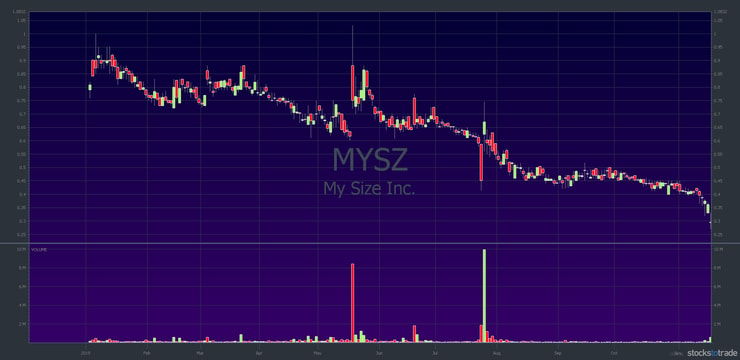
In November, it fell off a cliff. And it got worse…
Check out the chart after the reverse split. (Hint: the reverse split looks like a huge gap up on the chart below.) When it should have been trading in the $6s and $7s after the reverse split, it almost immediately tanked even more.
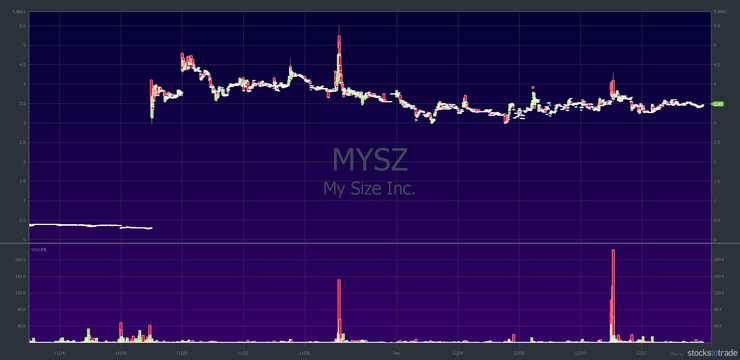
That’s what tax-loss selling looks like. It’s important to recognize this pattern. Because the price is so depressed, any potential positive news can spike the stock.
Onconova Therapeutics, Inc. (NASDAQ: ONTX)
As you can see from the chart, ONTX started downtrending in the middle of the year. Then in September, it started dropping hard and didn’t come back. It even had a few morning gap downs.
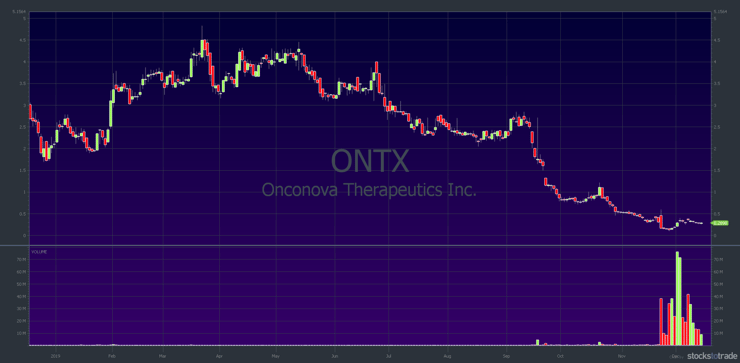
The company had bad news, so maybe it deserved to be pushed down this far. But either way, you have tax-loss selling pushing the price down further. And you have short-sellers jumping in to get a piece of the move.
So, when you have these beaten-down stocks and then you get tax-loss selling and short sellers…
… it creates a lot of depressed stock prices. And that allows for short squeezes, holiday spikes, and the January effect.
How Tax-Loss Selling Can Set Up Short Squeezes
Watch these beaten-down stocks for a potential short squeeze.
Over-aggressive shorts are getting squeezed a lot lately. So short squeezes are great to look for right now. And going long during a squeeze can be a good strategy for anyone with a small account. The percent gain potential is huge. Some of these stocks can spike 100%–200% in a day.
(I’m not the best at trading short squeezes because they move so fast and can be very scary. But several Trading Challenge students are killing it during the recent short squeezes.)
That’s because short-sellers have to buy to cover their positions. When a stock releases good news, the shorts try to get out — that means more buying. Combine that with longs who want to get in on the spike, and that adds up to a lot of buyers for the stock.
Lots of buyers cause the stock price to go up. It’s supply and demand. The more demand for the stock, the higher the price has to go to entice people to sell to meet the demand.
Low-float stocks are especially volatile. That’s because there’s a low supply. When demand increases, it can create huge price swings. These price swings are usually quicker in low-floats than a higher float stock.
A short squeeze can be a very quick spike, or it can be an all-day uptrend. It depends on how stubborn the shorts are.
But remember, these spikes won’t last more than a day or so. Sometimes it will only be one holiday morning spike. So be careful with dip buying — the stock might not bounce. A spike in the stock price isn’t a turnaround of the company’s valuation. Be ready to get out quickly.
Short selling isn’t a good strategy for new traders. Newbie short-sellers are annihilating their accounts. The big money doesn’t care. They have more money to play with. They just keep selling the idea to new, inexperienced traders.
Here’s how you should be trading with a small account: https://t.co/IZtSm9irAB if anything, it’s actually a smart move! $FB $TWTR
— Timothy Sykes (@timothysykes) December 12, 2019
Beaten-Down Stocks Can Become Holiday Spikers
This is something you can use: recognize the worst companies in the world can become the biggest and fastest spikers. How? Tax-loss selling and aggressive shorts compress penny stocks near the year’s end. Then, any good news combined with holiday trading can spike the stock.
During the holidays, there are also a lot of people at home who decide to try their luck at trading. This brings more uneducated people into the market. Learn to take advantage of that informational inefficiency.
Also, there’s increased volatility due to the shortened trading days. That means holiday spikes are usually very quick. You need to be prepared to act quickly. You should be studying so you can recognize the tax-loss selling ahead of time. Be ready for possible spikes.
I don’t usually follow stocks right at their lows. But if you’re watching for stocks with depressed prices, you can be prepared for the opportunity.
Let’s look at a few examples…
More Breaking News
- NU Stock Observes New Trends: Buy or Wait?
- Guidewire Software’s Surprising Surge: A Deeper Look
- WBD Stock Surges: Future Prospects Analyzed
ASLAN Pharmaceuticals (NASDAQ: ASLN)
Take a look at the daily chart for ASLN. The entire year it’s downtrending. Then at the end of the year, it’s one of the most popular stocks. Did it suddenly become an amazing company? No — it probably just got a little undervalued from all the selling pressure.
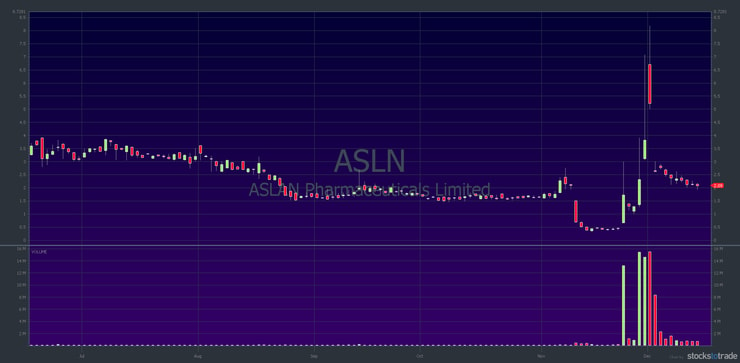
The company didn’t even have good news when it spiked. It spiked a few times for two days, but the shorts were being stubborn and kept pushing it down. Finally, on the shortened holiday trading day, the stock finally squeezed them all … it went from the $5s to the $8s!
This is a good example of a single holiday spike. There was no follow-up bounce or further play on this stock after the initial spike.
Can-Fite BioPharma Ltd. (NASDAQ: CANF)
Looking at the chart for CANF, you can see that it’s been beaten down all year. It started the year in the $20 range. Then it tanked and consolidated around the $2s.
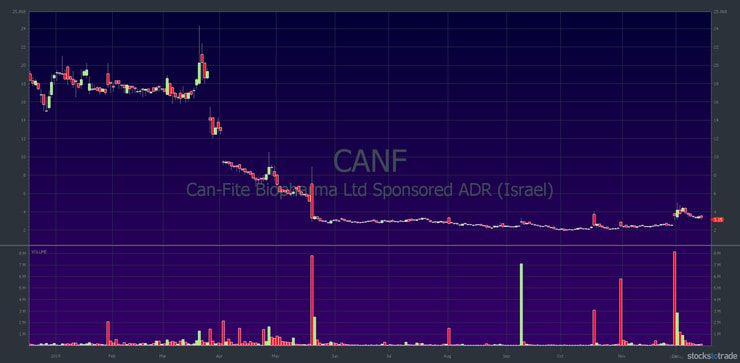
Then on November 29, a shortened trading day, the stock gapped up and opened in the 3.70s from a previous close in the $2.50s. In this case, the stock didn’t continue to spike that day.
But, on the next trading day, Monday, December 2, the stock did spike. It squeezed the shorts from the $3.40s up to $4.95.
As you can see, it’s not an exact science. But anything with a beaten-down chart — especially over the last few weeks — can spike back very quickly. So focus on the most beaten-down stocks as year-end approaches. Be ready to react to any potential good news or short squeeze that can create spikes.
The January Effect
The January effect is the historic tendency for the markets to rise in January. There are a few possible theories on what causes the trend.
The most obvious is that investors are buying back positions they sold before the end of the year. They got to take advantage of the tax-loss, and they can buy the shares back at a reduced price. It’s a win-win situation.
Another possibility for the rise in the market is that it’s a new year — it’s like a fresh start. People feel renewed, positive, and optimistic about the future. That can transfer to how traders view the stock market.
People usually set New Year’s resolutions and goals for the year. They may have new financial targets or retirement plans, and those may include buying investments.
A third possibility is that people who receive holiday or year-end bonuses use that money to buy investments in the new year.
No matter the exact cause, it means more buyers in the market. And more buyers can create great opportunities for going long.
Dreaming big is easy, but will you have the dedication and patience to truly do the hard work required to make your dreams a reality?
— Timothy Sykes (@timothysykes) December 7, 2019
The Final Word
Remember, low-priced stocks are some of the most volatile stocks in the market. With the year-end tax-loss selling and the short squeezes we’ve seen lately, there can be huge swings in prices.
Watch the chart patterns play out and carefully choose your entry. Trade like a sniper and react to the stock moves.
Trading can be counterintuitive. Don’t waste your time trying to predict stock movements. I prefer to react to the stock moves, not predict them. And don’t let your opinions get in your way — the stock market doesn’t care what you think.
And if a trade isn’t going your way, remember rule #1 and cut your losses quickly.
Tell me what you think! Leave a comment … I love to hear from you.







Leave a reply